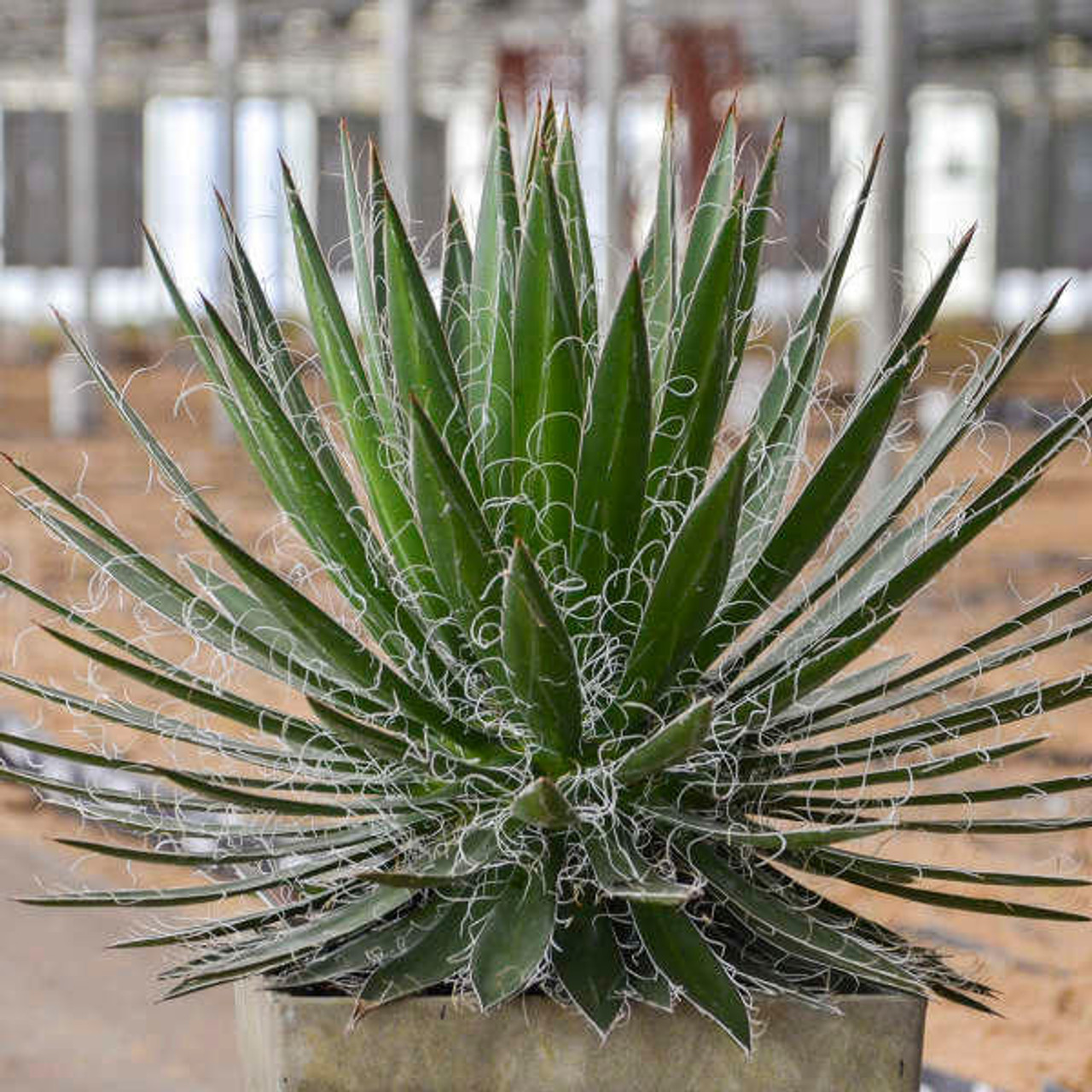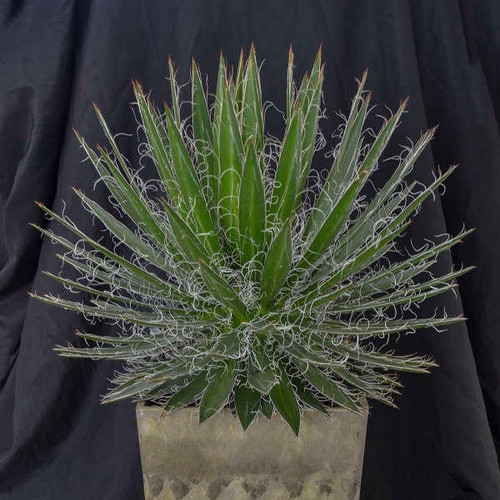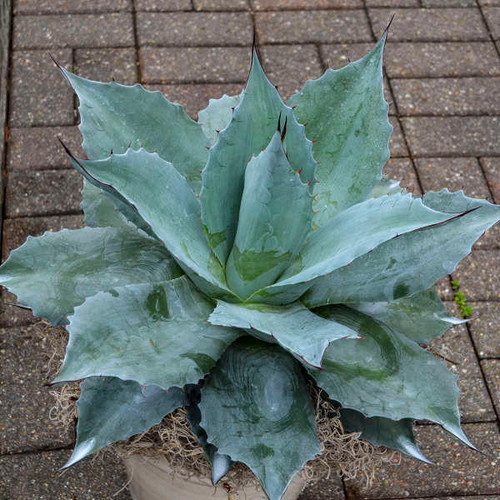Product Description
Agave schidigera 'Black Widow'(72)ct Flat
Common Name: Century Plant
The white "hairs" of this succulent are reminiscent of the fine texture of a spider's web. Spiky, sword-like leaves are green, long, white fibers lining the margin. Forms a compact, symmetrical habit.
The common name "Century Plant" is alluding to the belief that it takes 100 years to bloom. In reality, Agaves bloom after 15-20 years, and the main crown dies after blooming.
Agave is a tender perennial or "temperennial" succulent plant that grows best in full sun. Light afternoon shade is recommended in the hottest parts of the country. Plant in well-drained, dry to average soil in containers just slightly wider than the width of the rosette or plant directly in the ground. In summer when the plants are actively growing, they appreciate a bit of supplemental watering and half-strength fertilizer. They should be grown dry in winter. Agave is a slower grower, so it will not quickly overtake the space it is allotted in the landscape.
Height: 12.0-16.0 Inches
Spread: 18.0-22.0 Inches
Hardiness Zones: 8B,9,10
Foliage Color: Green shades
Full Sun (> 6 hrs. Direct Sun)
Low Water Needs
Poor to Average Soil Quality
Deer and Rabbit Resistant
Growth Rate: Slow
Container, Drought Tolerant, Attractive Foliage, Specimen, Native to North America
Agave schidigera 'Black Widow' is a captivating succulent that adds a touch of mystery and intrigue to gardens with its dark green foliage, dramatic white fibers, and compact form. Here is what makes it special:
What Makes Agave schidigera 'Black Widow' Special
- Web-like Fibers: The most distinctive feature of 'Black Widow' is the abundance of long, white, curly fibers that emerge from the edges of its leaves. These fibers resemble a spider's web, giving the plant its intriguing name.
- Compact, Symmetrical Rosette: It forms a dense, symmetrical rosette of dark green leaves, each tipped with a sharp terminal spine. The compact growth habit makes it a great choice for smaller gardens or containers.
- Architectural Form: The stiff, upright leaves create a strong architectural presence, adding a bold statement to the landscape.
- Slow-Growing: It is a slow-growing agave, which means it will maintain its compact shape for many years. This makes it a good choice for gardeners who want a low-maintenance plant that does not require frequent repotting or dividing.
- Drought Tolerant: Like other agaves, 'Black Widow' is highly tolerant of drought conditions, making it a great choice for xeriscaping or low-water gardens.
Description and Details
- Common Name: Black Widow Agave, Century Plant
- Botanical Name: Agave schidigera 'Black Widow'
- Mature Size: 18 inches tall, 22 inches wide
- Foliage: Dark green leaves with white, web-like fibers along the edges
- Flowers: Yellowish-green flowers on a tall stalk (infrequent bloomer)
- Growth Habit: Solitary rosette (does not form offsets)
- Hardiness Zones: 8-10
- Light: Full sun
- Soil: Well-drained, sandy or rocky soil
- Water: Drought-tolerant once established
Landscaping Design Tips
- Specimen Plant: Its unique form and web-like fibers make it an excellent specimen plant, where it can be the focal point of a garden bed or landscape.
- Xeriscaping: It is a perfect choice for xeriscaping or drought-tolerant gardens, where it can thrive with minimal water.
- Rock Gardens: It is also a good choice for rock gardens, where their architectural form and texture can complement the rocks and other succulents.
- Containers: It is well-suited for containers, adding a bold statement to patios and balconies.
- Companion Plants: Consider pairing them with other drought-tolerant plants that offer contrasting colors and textures, such as:
- Yuccas
- Sedums
- Grasses
- Salvias
Planting and Care
- Planting:
- Choose a sunny location with well-drained soil.
- Plant in spring or fall.
- Dig a hole twice as wide as the root ball and just as deep.
- Place the plant in the hole and backfill with soil, making sure the crown is level with the surrounding ground.
- Water thoroughly after planting.
- Care:
- Water deeply but infrequently, allowing the soil to dry out completely between waterings.
- Avoid overwatering, as this can lead to root rot.
- No fertilization is needed.
- Remove any dead or damaged leaves.
- Protect from frost in colder climates.
Additional Notes
- 'Black Widow' is a slow-growing agave, but it is well worth the wait for its mature beauty.
- It is a monocarpic plant, meaning it will flower only once in its lifetime, usually after 15-20 years. After flowering, the main rosette will die.
- The leaves have sharp spines, so it is best to plant them away from high-traffic areas and walkways.
- It is a great choice for gardeners looking for a low-maintenance, drought-tolerant plant that adds a unique and dramatic element to the landscape.
Other Details
The most important part of the plant is its root system. Healthy roots are the foundation of a healthy, vibrant plant. The type of plug container used is based on the specific needs of the plants. Perennials offered as bare root traditionally perform better when planted as bare root.Planted in a specialized mix, potted plants have well established root systems. Top growth stage will vary depending on the current life cycle and time of year when shipped. In Winter and early Spring dormant plants may be shipped. Dormant plants may be planted right away, even before the last frost date.
Most bare root varieties are field grown for at least one season, though Hemerocallis and Hosta are grown for two seasons. The bulk of the soil is removed during the harvesting process and the tops of most varieties are trimmed back to the crown. They are graded, packed in shredded aspen or sphagnum moss and stored in freezers until ready to be shipped.
See our Container Sizes and Bare Root Perennials pages for more information.
Plant information and care is provided in the Overview section, Plant Genus Page and general information is provided in the Planting Care & Guides. Additional questions can be asked on each Plant page.
Plant Spacing: Using the maximum mature spread or width of a plant to guide spacing, ensures space to grow to full size. To fill an area sooner, plant them closer together. Just remember, future thinning or transplanting may be needed.
Water: Keep a close eye on newly planted perennials, especially throughout the first growing year. Most early plant loss is due to too much or too little water!














